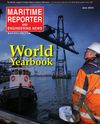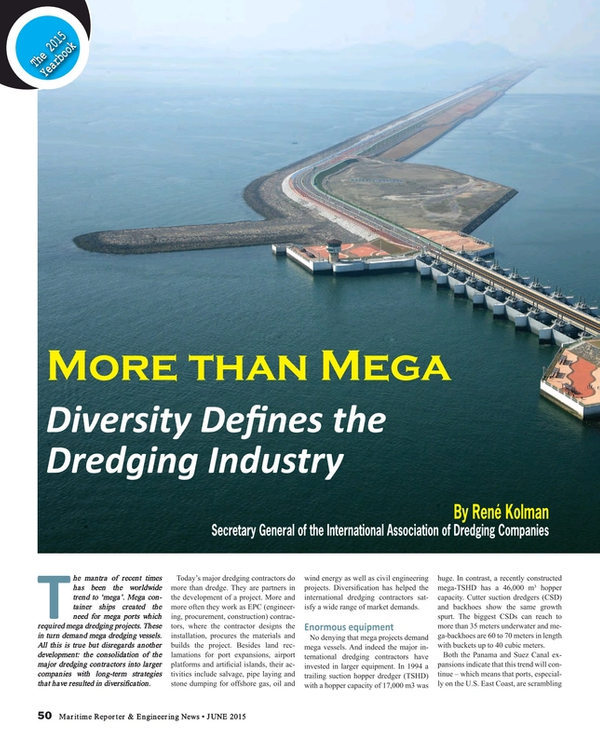
More than Mega: Diversity Defines the Dredging Industry
The mantra of recent times has been the worldwide trend to ‘mega’. Mega container ships created the need for mega ports which required mega dredging projects. These in turn demand mega dredging vessels. All this is true but disregards another development: the consolidation of the major dredging contractors into larger companies with long-term strategies that have resulted in diversification.
Today’s major dredging contractors do more than dredge. They are partners in the development of a project. More and more often they work as EPC (engineering, procurement, construction) contractors, where the contractor designs the installation, procures the materials and builds the project. Besides land reclamations for port expansions, airport platforms and artificial islands, their activities include salvage, pipe laying and stone dumping for offshore gas, oil and wind energy as well as civil engineering projects. Diversification has helped the international dredging contractors satisfy a wide range of market demands.
Enormous equipment
No denying that mega projects demand mega vessels. And indeed the major international dredging contractors have invested in larger equipment. In 1994 a trailing suction hopper dredger (TSHD) with a hopper capacity of 17,000 m3 was huge. In contrast, a recently constructed mega-TSHD has a 46,000 m³ hopper capacity. Cutter suction dredgers (CSD) and backhoes show the same growth spurt. The biggest CSDs can reach to more than 35 meters underwater and mega-backhoes are 60 to 70 meters in length with buckets up to 40 cubic meters.
Both the Panama and Suez Canal expansions indicate that this trend will continue – which means that ports, especially on the U.S. East Coast, are scrambling to deepen and widen access channels and berths. That said, new vessels on order are not just about size; they are about technology, as contractors confront other challenges like fuel emissions and environment.
Going “green”
Since ships move across vast international bodies of water, their fuel emissions during sailing know no boundaries. The International Maritime Organization (IMO), a United Nations agency, is therefore responsible for legislation that addresses the reduction of greenhouse gases caused by fuel emissions. This is not easy: emissions from freight ships differ from dredging vessels even if some dredgers are self-propelled and seagoing. But dredgers are also workboats. Standing still while at work, they are still expelling emissions. A worldwide reduction in emissions of SOx, NOx and Particulate Matter plus the introduction of Emission Control Areas (ECAs) has culminated in new limitations on SOx for parts of the North Sea and the California coast as of January 1, 2015.
One way to meet these requirements is with “green” dredging vessels, built with environmentally sound technologies like dual fuel engines and LNG tanks. Dual fuel technology is sustainable, allowing engines to operate on either diesel or LNG while limiting the CO2, Nox and SOx emissions to the strictest minimum.
Protecting natural habitats at dredging sites is also a necessity and a priority. Research for technologies to more accurately monitor the effects of dredging on marine fauna and flora is ongoing. One of these efforts, “Building with Nature,” grew into a knowledge institute supported by an industry-government partnership (www.ecoshape.nl).
It emphasizes building hydraulic infrastructures that utilize natural processes and provide opportunities for nature. Another industry effort is focused on the “Ecosystem Services” concept, in which the value of infrastructure construction and that of natural assets can be evaluated.
Climate change awareness
More than 80 percent of the world’s population lives near water. From Bangladesh and the Maldives to Miami, New York and the Netherlands, these populations and property are vulnerable. With the threats of climate change and consequent risk of flooding caused by rising sea levels now in full focus, the dredging industry has a crucial role to fulfil in coastal protection. Preventing shore erosion requires vigilance and innovative maritime solutions now and in the future.
Old markets, new markets
China has clearly emerged as a formidable force in maritime construction. Trade routes from east to west, from Asia to Europe, are plowed by the largest container ships ranging from 18,000 to 19,000 TEUs. But this has created another trend of north-south cascading trade routes taking advantage of smaller container ships heading to African ports. If this trend continues these ports will require modernization.
After the legendary works in Asia and the Middle East, the construction of artificial islands through land reclamation has expanded exponentially. It remains an economically viable means to meet the need for more land for a variety of uses. Brazil’s Superporto do Açu and other South American ports testify to this. Not to forget the burgeoning Caribbean cruise industry with its floating skyscrapers that need ever-larger berths. Artificial islands are even being used to replace traditional gas and oil platforms.
Indeed, the offshore energy sector continues to be an important client for dredging contractors. Also in the renewable energy sector, where the popularity of offshore wind parks in Northern Europe has gained momentum and utilizes the expertise of the dredging companies to install wind turbines.
Remediation of contaminated sediments in certain regions, especially the U.S. and Canada, remains important. The Great Lakes clean-up and Superfund river projects are crucial to reversing earlier industrial pollution and ensuring clean water. Sweden has also committed to the remediation of its pristine fjords.
And finally, the opening up of the Russian and Canadian Arctic shipping passageways are creating opportunities for the dredging industry as well. Deep sea excavation systems are being developed that allow dredging to take place at depths varying from 100 to at least 1,000 meters.
Strengthening safety standards
Though it sounds obvious, safety is the highest priority within every project. The goal of achieving no incidents/no accidents on every job demands training programs, management participation and internal and external auditing. The international dredging contractors are instituting more and more programs to meet the highest standards of quality, health, safety and environment (QHSE).
IADC’s communication challenge
For the International Association of Dredging Companies (IADC) the challenge is to explain the hows, whys and benefits of dredging. It is not amazing but most people have no idea what dredging is. Then again, how often does a dredging project occur in your neighbourhood? The tendency of stakeholders to react with ‘NIMBY’ attitudes (‘Not in My Backyard’) is still too prevalent.
The IADC aims to dispel the mystery and misunderstandings, helping stakeholders understand the engineering complexities and balanced approach of maritime construction projects. While representing the private dredging industry, the IADC is always ready to promote dredging in general. A high tide lifts all ships. Through its webinars and seminars, networking with other maritime organizations and by supporting scientific research and publications, the IADC reaches out to clients and communities. Terra et Aqua Journal and the IADC’s Facts About series offer technical dredging information as do reference books like Hydraulic Fill Manual and Environmental Aspects of Dredging co-published by the IADC. The annual IADC publication Dredging in Figures compiles global statistics on all dredging endeavours, private and public, in open and closed markets.
A dredging project is an engine for social and economic progress. The IADC and its members strive for sustainable maritime construction that improves people’s quality of life. This is not a trend – it is a permanent long-term goal.
A Limited Edition Book
To celebrate a half century of maritime infrastructure construction, the IADC members dug deep into their archives to gather photographs of 50 major projects realised over the last 50 years. These photos and descriptions illustrate vividly that dredging is far more than excavating sand and placing it in the sea. The book defines where the dredging industry started and how far it has evolved into a supplier of essential maritime infrastructure for land development, the oil and gas offshore industry, wind energy, ports and harbours and coastal protection in these times of climate change.
BOOK INFORMATION
Format: 25 x 25 cm, softcover
Language: English
Price: € 24.95 (Excluding shipping costs)
www.iadc-dredging.com
(As published in the June 2015 edition of Maritime Reporter & Engineering News - http://magazines.marinelink.com/Magazines/MaritimeReporter)
Read More than Mega: Diversity Defines the Dredging Industry in Pdf, Flash or Html5 edition of June 2015 Maritime Reporter
Other stories from June 2015 issue
Content
- Van Oord Develops Deep Excavation System page: 8
- Driving Innovation: the Unmanned FLNG page: 10
- Marine Casualty Reporting: Addressing the Coast Guard's Processes page: 16
- Ship Design: Survivability Measures to Quantify Combat Capability page: 18
- Global Maritime Trends: U.S. Shipbuilding Will be Vibrant for a Generation page: 28
- Oil’s Downward Spiral Stalls LNG’s Ascent page: 34
- 'Corporate Ocean Responsibility' page: 46
- More than Mega: Diversity Defines the Dredging Industry page: 50
- Offshore Renewables: The Future is Now page: 54
- A chat with John Murray, Chief Executive, Society of Maritime Industries page: 56
- UK Seeks Maritime Dominance of Yore page: 58
- Maritime Ireland Comes of Age page: 60


